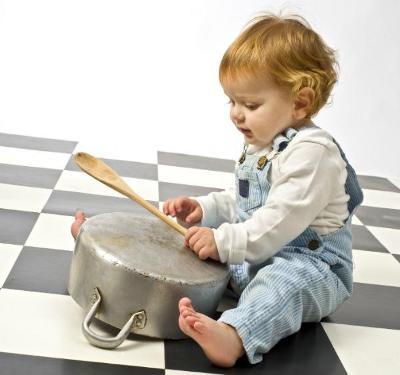Heuristic play

Child psychologist Elinor Goldschmeid, who developed treasure baskets for babies, also promoted heuristic play for toddlers.
She noticed how interested toddlers are when they explore objects from the real world. You might know children who left their toys to play with pans and spoons, or opened a present only to play with the paper or the box.
The word "heuristic" means to discover or learn something for yourself. It's a hands on approach which stimulates the senses.
When we give toddlers a collection of safe and interesting items, they explore and discover what they can do with the items. Toddlers often think of lots of uses for an item - a pan isn't just for cooking, it can be a drum, a hat, a bed for a toy etc.
Many baby and toddler toys are plastic or fabric, which is very practical. But toddlers learn from experiencing the cold of a metal pan, the scratchiness of a (new) kitchen sponge and the way a tin of beans rolls across the floor.
Toddlers are like tiny scientists, eager to find out what each item is like, and what it can do. Many will put smaller items into bigger ones or build towers. It can be interesting to notice what your child is most interested in and what they do.
Toddlers interested in a sound or feel of an object often repeat an action over and over. This supports brain development as well as muscle control and hand/eye co-ordination.
Ideas for heuristic play
Try offering toddlers a range of objects that will stimulate their senses. Put them in a shoe box, or basket. Think about the colour, shape and feel of the object.
Be careful to watch out for sharp edges or any small bits that could break off and choke or harm your toddler.
Never leave your child by themselves when they are playing with these objects.
Possible objects for your toddler to explore:
- Small pan
- Metal, plastic and wooden spoons
- A DVD or CD that you no longer want to use
- An orange, lime or lemon
- A small piece of edible herb, such as lavender, basil or mint
- Bells
- A bracelet
- Homemade shakers (plastic bottles containing coloured rice, glued shut for safety)
- A silky ribbon or scarf
- Small and safe boxes or tins
- A cleaned stone, pine cone or shell (hand sized)
Further information
For more information and ideas go to:
- www.pinterest.co.uk/NorfolkFIS/toddler-play-and-discover/ (opens new window)
- www.pinterest.co.uk/NorfolkFIS/2020-toddlers-learning-at-home/ (opens new window)
- www.bbc.co.uk/tiny-happy-people/explore-a-treasure-box-18-24/zkyyy9q (opens new window)

